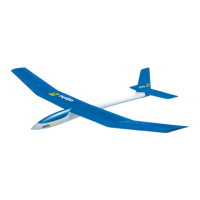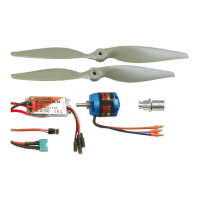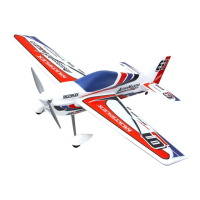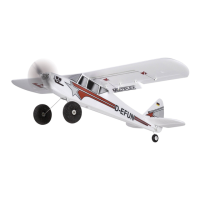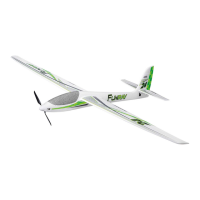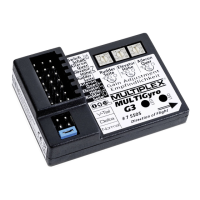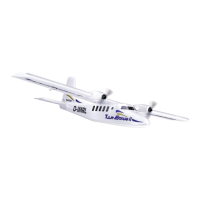that the trailing edge of the wing
and the
leading
edge oI the aile-
ron were lett with a
straight, sharp edge, as described in the
building instructions.
Connect the threaded
pushrod
to the aileron horn
and check
the aileron movement. Apply
a small blob of s-minute epoxy to
the end of the
pushrod
to
secure
it. Repeat
the
procedure
with
the
second
aileron.
Applying the transfers
Cut out each transfer, leaving
about 1mm
excess
all round.
Leave the backing film in
place
lor
the moment. Place the trans-
fer on the model
and establish the
correct
position.
lt is a
good
idea to mark the
position.
but make sure the mark
can be erased
again later.
Cut
a
strip about
10 mm
wide from the
backing
film,
leaving the
rest of the backing on the
transler.
Position
the transler
on
the
model
and rub the exposed
edge
in
place.
The rest of the
back-
ing film can now
be
peeled
off and the transfer
pressed
down.
Take
care not to allow any
air bubbles; always rub trom
the
centre towards the edge. Take
care not to
pullthe
transfers
out
ot
shape.
Large transfers
cannot be applied as
just
described; they are
attached as follows:
squirt a few drops of liquid detergent into
a
bowl of
water
and dampen
the
model
with the mixture
(the
sur-
face must be waterproof).
Remove the backing film
entirely and
apply the transfer to the model. The water
prevents
the adhesive
grabbing,
and the
transfer can be
slid
into
position
and
smoothed down. The film
oI
water
under the transter will
diffuse
afteradayortwo,
and the transfer willstick
just
as if applied dry.
The
pre-condition
for
this to work
is: the surface must
be
smoolh, and
free
of dust and
grease.
lnstalling
the radio
control equipment
Installthe
servos in the fuselage. Fitthe
clevis 40about halt-way
onto the threaded
portion
of the threaded
coupler 41, and con-
nect the link to the
servo output arm. The
guide
tubes
already in
place
in the fuselage
usually have to
be shortened in the cabin
area. They
can be cut through with a
sharp knife, leaving suflic-
ient
soace between servo
outout arm and tube end for a clevis
and
threaded couDler.
Set the control
surfaces and servos to neutral,
and the air-
brakes to fully
closed. Mark the correct length
ol the linkage
rods forthe control
surtaces
(the
depth ofthe hole in
the thread-
ed
coupler
is
about
l0
mm) using a telt
-
tip
pen,
cut the rods to
length and de-burr the
cut ends.
Check that the bowden
cables are as straight as
possible,
and
give
them extra support by
gluing
them to the fuselage side at.
several
points
with
epoxy. The tube
ends can be secured with
the
guide
tube supports 38, which
are
glued
to the rear former.
Check that the control surface neutral
oositions and throws are
correct, and check that
all systems work freely.
Check also that
the control
"sense"
is correct, i.e. moving
the rudder stick to the
right results
in the rudder moving to
the
right.
ll necessary re-
verse the servos at
the transmitter, or installa
servo
reverse mo-
dule.
Check
that all
control surfaces, and in
particular
the airbrakes,
are able to move
to the servos' extremes
of
travel without
being
mechanically
obstructed at any
point.
A
stalled servo consumes
a very high current, and
thus depletes the receiver
battery
in
a
very
short time.
Fit the receiver
battery into the fuselage nose
and
pack
round it
with foam
rubber. The receiver
battery should have a capacity ot
at least'1200 mAh. For
extra security, we recommend
using the
Secu battery system.
The receiver can be fixed to the luselage
side using Velcro, or
wrapped in foam rubber
and fixed on
a separate
plate.
The
re-
ceiver aerial can usually be deployed inside
the
luselage
by
slipping
it inside
a
length
ol
plastictubing
(bowden
cable outer),
which is left loose in the luselage.
On no account
use
metaltu-
bing!
Mount
the On/Off switch on
the servo olate 31 inside the tusel-
age. The
canopy
is removed
to switch the radio
on or ofl.
Balancing
Your model must be balanced
at the marked Centre ot Gravity
before
you
attempt a flight. Minor
inaccuracies in
construction,
which
are unavoidable in modelling, mean
that the
perfect
ba-
lance
point
is slightly
dillerent
for
each model. For this reason
20
the
model is
initially balanced at an average CG
position,
which
will
always be accurate enough for test flights. The ideal
CG
po-
sition can then be
established
tor
your particular
model during
test
-
tlying.
The average CGforthe Alpina maglc is about
85
mm
behind the wing root leading
edge.
Mark the CG on the underside
of
the wing roots
using a
felt
-
tip
pen.
Fit out the model
completely,
including radio
equipment,
canopy and tail surtaces. The model can simply be balanced on
your
fingertips;
this
is
quite
accurate enough for the initial aver-
age CG
position.
Add lead
ballast lo the
tuselage
nose until the
model
balances with the nose inclined
slightly down. You will
need between l00
and 300
grams
of lead, depending
on
your
methods of
construction and
finishing
and the type of radio ins-
talled. Be sure to
prevent
the
ballast shifting: screw or epoxy it in
prace.
Test
-
flying
The satest method of launching lor the first flight
is an aero
-
tow,
although the slope or a winch
are
pertectly practical.
Switch the
receiving
system on and carry
out
a
check of all controls. Check
once more that the
control surtaces move in the correct
direc-
tion corresponding to stick movement.
Carry out a range test.
It
you
run fast into
the
wind,
and release the model momentarily,
you
can
get
an idea of the model's longitudinaltrim:
there
must
be
no marked
tendency to
change
aftitude. Don't
throw the mo-
del!
For a winch launch, it
is best if an assistant holds the model and
checks that the wings are level. ll
you
are using a
grass
strip,
grass
must
be shaved really close!
Do not release
the
model
untilthe tension on the line is
just
right
(not
too
great,
and not too little). lmmediately after leaving
the
ground
the model is in
the most dangerous
phase
of the launch.
lf the model is allowed to
climb away steeply
from
the
ground,
one
wing is very likely
to stall; the model will drop one wing and
can only be
recovered
by applying down elevator and opposite
rudder at once. ln this situation it is vital
that the
winch
operator
should not slacken the tension
on the line, otherwise the model
will have no
energy available for a change in
course.
To
avoid
this situation, never
pull
the model
up steeply
immediately
after
lift
-
off, but wait a few moments until it has achieved flying
speed, even applying a
little
down
-
elevator if necessary. A fur-
ther reason for this
Drocedure
is
that
it reduces
the risk oI a
cable break at low altitude.
Once the
model
is in a stable condi-
tion, the
climb can be continued; apply slight up
-
elevator to
maximise
launch height.
The winch
operator should watch the degree of flex in the wings
.during
the whole of the winch launch,
as this
indicates
the load
on the model,
and tells him whether to apply more or less
power.
After releasing
the tow, trim the model for accurate
straight
flight, with
the
fuselage
pointing
in exactlythe same direction
as
the direction of f light
-
into wind
and downwind.
This
is of
gt
importance if
you
wish
to obtain maximum
performance
frofl
your
model. An
aircraft
which
is constantly
yawing
can never
give
its best
performance,
owing
to increased tuselage
drag
and the angled airtlow over the wings.
Now tly
a
few
full circles, if
possible
in both directions, and ob-
serve how the control
surfaces
respond. lt is worth
saying here
that all
pilots
develop their own ideas
on
how to fly
an aircraft,
and we
can only
give general
advice.
lf
you
find one
control operates too sharply or too sluggishly, eli-
minate
the
problem
at once by reconnecting the linkage at the
servo output arm. lt makes no sense at all to fly a model for a
long time with unbalanced
control
responses. Neither
is it
good
practice
to use the transmitter throw reduction switches
(rate
switches or similar) as a
permanent
means ol trimming, as in
this way
you
lose the
precision
aftorded
by
full
servo throw.
Equally, do not alter the
settings once
you
have
established a
good
combination. The clevises, once adjusted
correctly,
can
be locked with locknuts,
contact cement or silicone adhesive.
lt
takes a
pilot
a
certain amount of time to
get
the best
pertor-
mance
out ot any sailplane, even under constant conditions.
lf
you
still have enough height,
check
the
CG
position
right on
your
lirst tesl flight. However,
do not attempt it if
you
are
getting
low. lt is much better in that case to land and carry out the test
during a second
flight.
The
simplest and
quickest
method of checking the CG is to in-
vestigate
the model's recovery from an intentional
dive.
This
characteristic is a function of the interaction
between Centre of

